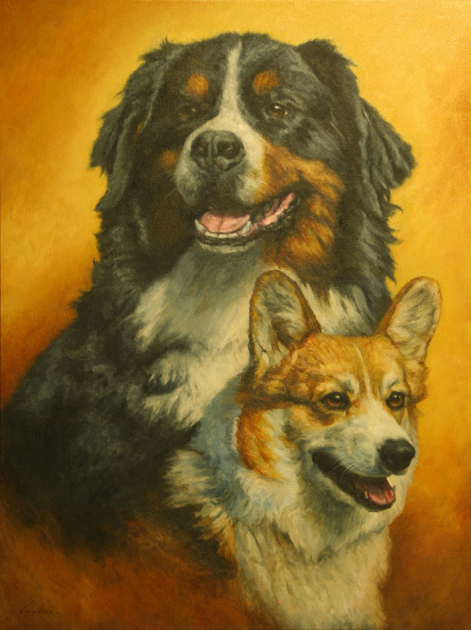Oil Painting Progression, Part 6 – “The Finished Work”
Today, we’re going to be looking at the stuff dreams are made of – that is if you’re like me and go to sleep thinking about pretty pictures. All (or some) kidding aside, there may be exceptions, but many artists like myself, who love to paint, do receive a special joy when having accomplished the many stages that lead up to calling an artwork “finished.” If I may wax philosophical for a moment, the foregoing has likely been a topic of great curiosity and discussion among certain artists and art enthusiasts for centuries – “how do you know when a painting is finished?” Some have indicated that an artwork is never truly finished, that the artist simply decides when to stop, or that it’s time to stop when the artist becomes disinterested in carrying it forward. Some say the artwork dictates to the artist when it’s complete, while others won’t call it a wrap until the piece is indistinguishable from a photograph. In reality, any of these descriptions is as valid as any other, it just depends on how a given piece is allowed to evolve and what the intentions of the artist are. Some would say it’s finished when it’s signed! As a realist painter, I’ve noticed lately that I can tell when a painting is nearing completion when the only corrections I’m making to it are tiny cosmetic touch-ups here and there. To me that indicates there are no larger distractions from the aesthetic intent of the work remaining. So, once those touch-ups are made, I can safely call the painting finished. If the piece were in need of any more major adjustments, those would typically have stood out to me beforehand.

“Larka & Dylan” (finished painting) by Dean Vigyikan
However, the jump from the image discussed in the last article to this one includes more work than mere touch-ups. We’re looking at numerous additions which required close observation and careful brushwork. This phase of painting is where pretty much every stroke counts because you know it’s not going to be covered up – this is the final surface which people will observe. Creating this final layer, while one of the most important steps to be sure, also happens to be one of my favorites. This is where my soul’s intent gets to manifest itself. Everything leading up to this point was laying the foundation, and all of it critical. Like the very skeleton of a bird supports the beautiful exterior feathers, as a Christmas tree provides a reason for the ornaments, the under layers of a painting are the structure on which an artist gets to hang the adornments of highlight, detail, and final nuance. Anything you haven’t gotten to say before, you get to say it here!
OK, so what’s been happening between these latest two stages? The most obvious addition is the eyes which, up until now, have been like ghosts, vanishing and reappearing, jostling for position in preparation for this all important final stage. Their proverbial Shakespearian role as “windows to the soul” I take quite literally, and their convincing position and execution in any portrait is critical in my opinion. As they are so expressive, they’re indeed one (or two) of my favorite things to paint. On the other end of the spectrum of obviousness, there are the tiny whiskers which, while no one would probably notice if left out, the dogs would know.
Also, among these small but important finishing touches, there are the many highlights throughout the furry areas which, as the fur has been trying to do all along, both show us the animals’ texture and, at least as importantly, define their form. Comparing the above image with the one in the previous article, it’s very noticeable that the canines have jumped a notch or two in their appearance of three-dimensionality. This is especially true with Larka, the Bernese mountain dog, who still suffered from fairly large areas of “black” flatness in the previous stage. Thanks to her newly added highlights, she not only has “real” fur now, but even more of a skull to boot! Just don’t take a boot to it – if I know Larka, she’s sweet but can have a nasty temper too. In wrapping up these defining characteristics to our two characters here, there were also important areas which had to be made more subtle. Note for example the slight nuancing which has taken place in Dylan’s jowls or Larka’s nose and mouth.
This was a unique process for me compared with any other artwork I’d created previously. For the first time, in a systematic way, I documented a painting’s progress from start to finish. I’m grateful to the person who commissioned me to paint this work for prompting me to chronicle its progression. As mentioned earlier, there are quite a few stages I’ve left out of this suite of articles in the interest of showing the most marked leaps in the picture’s development. As I’ve been narrating this series, it’s really made me look closely at the planning and effort involved in a project like this. The work was sometimes very intense, yet truly rewarding. It was a building process that ultimately allowed me to literally and figuratively round out the expression of these lovely animal subjects. I hope the thoughts I’ve shared give some insight, both technically and philosophically, into the painting process of a representational artist.
Once again, as a final note, these stages were photographed under incandescent light and haven’t been color corrected. Click here for a look at a photo of the painting that’s been color corrected to more closely resemble the original.
